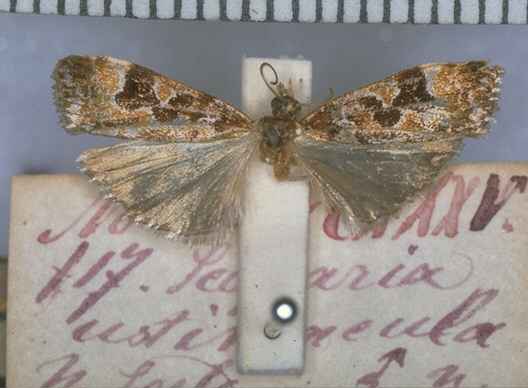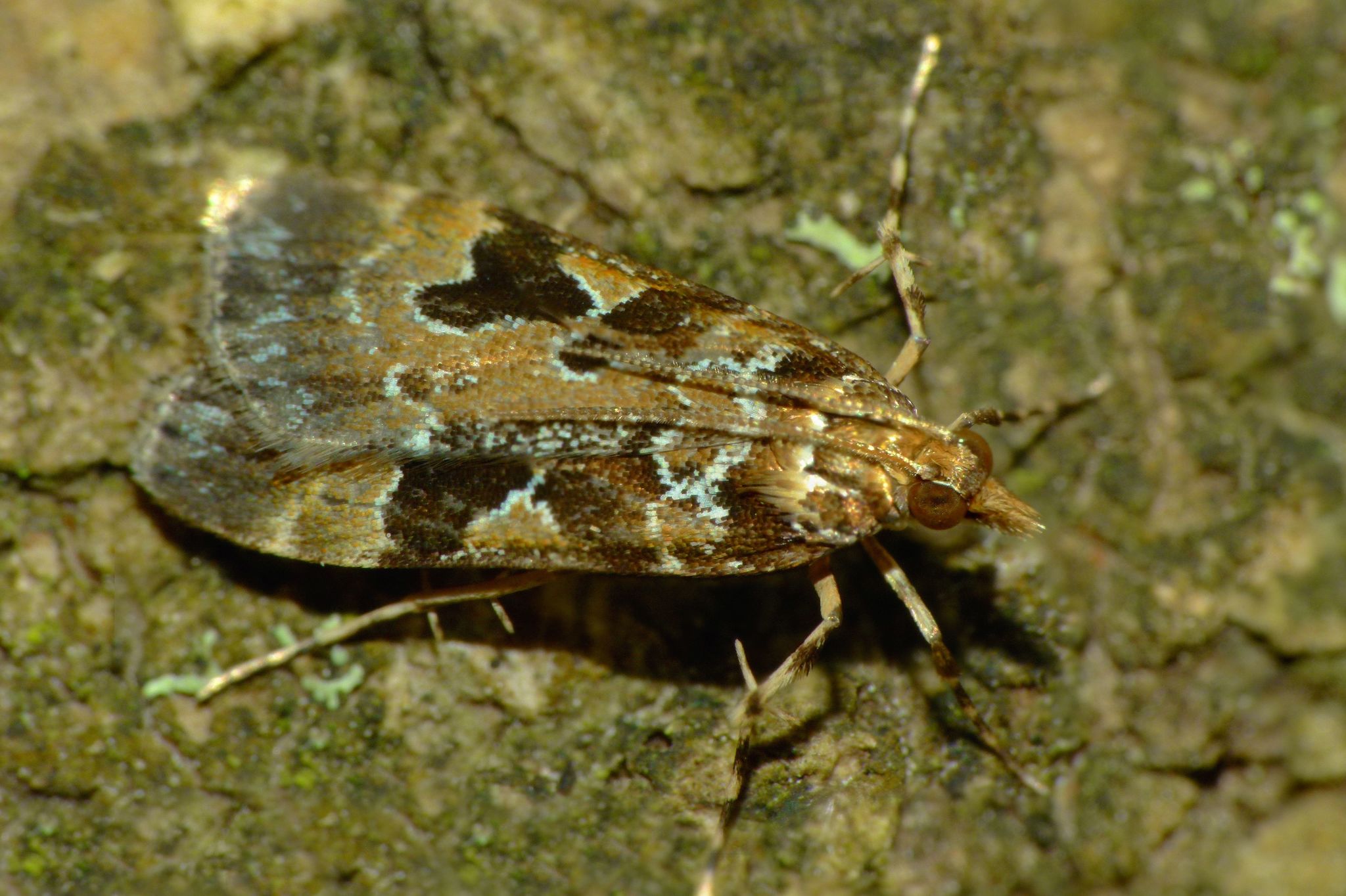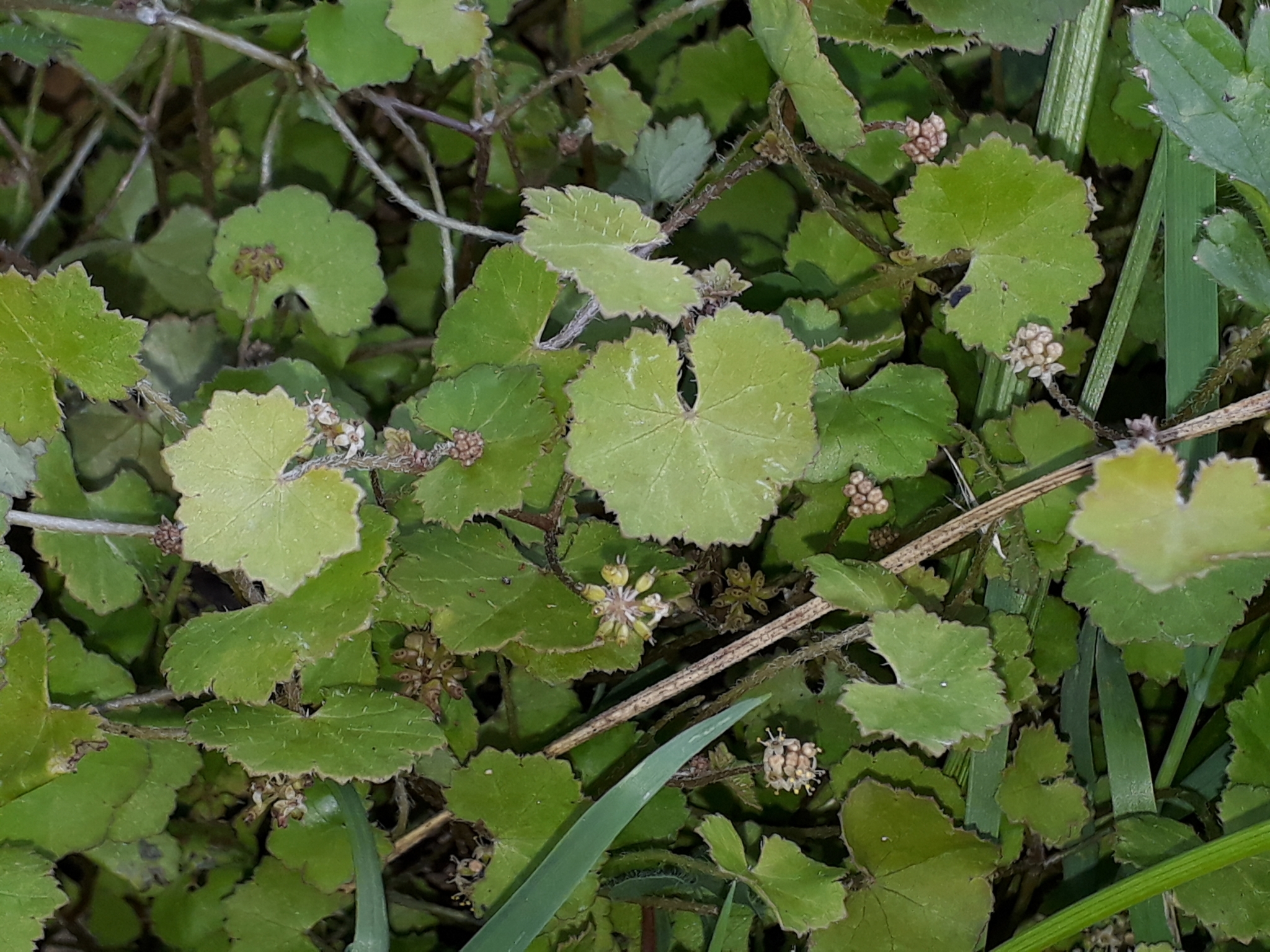Scoparia Ustimacula on:
[Wikipedia]
[Google]
[Amazon]
''Scoparia ustimacula'', also known as the black-marked brown Scoparia moth, is a species of

 Hudson described this species as follows:
This moth is distinctive in appearance and tends to be larger when collected at higher altitudes. ''S. ustimacula'' can be distinguished by the pair of large, dark brown, white boarded, forewing markings. Sometimes these patches join to form an M shape. The male of this species has long antennal ciliations.
Hudson described this species as follows:
This moth is distinctive in appearance and tends to be larger when collected at higher altitudes. ''S. ustimacula'' can be distinguished by the pair of large, dark brown, white boarded, forewing markings. Sometimes these patches join to form an M shape. The male of this species has long antennal ciliations.
 Although little is known of the life history of this moth, the larvae of ''S. ustimacula'' feed on ''
Although little is known of the life history of this moth, the larvae of ''S. ustimacula'' feed on ''
moth
Moths are a paraphyletic group of insects that includes all members of the order Lepidoptera that are not butterflies, with moths making up the vast majority of the order. There are thought to be approximately 160,000 species of moth, many of w ...
in the family Crambidae. It was described by Cajetan Felder
Baron Cajetan von Felder (german: link=no, Cajetan Freiherr von Felder; 19 September 1814 – 30 November 1894) was an Austrian lawyer, entomologist and liberal politician. He served as mayor of Vienna from 1868 to 1878.
Life and career
Felder ...
, Rudolf Felder
Rudolf Felder (2 May 1842 in Vienna – 29 March 1871 in Vienna) was an Austrian jurist and entomologist. He was mainly interested in Lepidoptera, amassing, with his father, Cajetan Felder, a huge collection.
Works
*with Cajetan Felder, Lepidopte ...
and Alois Friedrich Rogenhofer
Alois Friedrich Rogenhofer (22 December 1831, in Vienna – 15 January 1897, in Vienna) was an Austrian entomologist. He was a curator at the Naturhistorisches Museum in Vienna, where he was the first keeper of the Lepidoptera. Rogenhofer was main ...
in 1875. It is endemic
Endemism is the state of a species being found in a single defined geographic location, such as an island, state, nation, country or other defined zone; organisms that are indigenous to a place are not endemic to it if they are also found elsew ...
to New Zealand
New Zealand ( mi, Aotearoa ) is an island country in the southwestern Pacific Ocean. It consists of two main landmasses—the North Island () and the South Island ()—and over 700 smaller islands. It is the sixth-largest island count ...
and can be found in the North, South and Stewart Islands. This species inhabits dense native forest at altitudes from sea level to approximately 1000 m. Although little is known of the life history of this species, larvae have been observed feeding on ''Hydrocotyle
''Hydrocotyle'', also called floating pennywort, water pennywort, Indian pennywort, dollar weed, marsh penny, thick-leaved pennywort and even white rot is a genus of prostrate, perennial aquatic or semi-aquatic plants formerly classified in the f ...
'' species. Adults are on the wing year round but are more commonly observed from September to March. Adults are nocturnal, are attracted to light and have been collected by beating scrub.
Taxonomy
This species was first described by Cajetan Felder, Rudolf Felder and Alois Friedrich Rogenhofer in 1875 using specimens collected in Nelson by T. R. Oxley. Arthur Gardiner Butler, thinking he was describing a new species, named it ''Scoparia conifera'' in 1879. Edward Meyrick synonymised this name in 1884 and detailed the reasons for this decision in 1885. George Hudson described and illustrated the species in his 1928 book ''The butterflies and moths of New Zealand''. The maleholotype
A holotype is a single physical example (or illustration) of an organism, known to have been used when the species (or lower-ranked taxon) was formally described. It is either the single such physical example (or illustration) or one of several ...
is held at the Natural History Museum, London
The Natural History Museum in London is a museum that exhibits a vast range of specimens from various segments of natural history. It is one of three major museums on Exhibition Road in South Kensington, the others being the Science Museum an ...
.
Description

 Hudson described this species as follows:
This moth is distinctive in appearance and tends to be larger when collected at higher altitudes. ''S. ustimacula'' can be distinguished by the pair of large, dark brown, white boarded, forewing markings. Sometimes these patches join to form an M shape. The male of this species has long antennal ciliations.
Hudson described this species as follows:
This moth is distinctive in appearance and tends to be larger when collected at higher altitudes. ''S. ustimacula'' can be distinguished by the pair of large, dark brown, white boarded, forewing markings. Sometimes these patches join to form an M shape. The male of this species has long antennal ciliations.
Distribution
This species is endemic to New Zealand and is found throughout the country. It is regarded as being fairly common.Habitat
''S. ustimacula'' inhabits dense native forested areas and can be collected by beating the scrub and overhanging forest branches. This species can be found at altitudes from sea level up to approximately 1000 m.Behaviour
The adults of this species are on the wing throughout the year but are more frequently seen from September to March. The adults active at night and are attracted to light.Host species
 Although little is known of the life history of this moth, the larvae of ''S. ustimacula'' feed on ''
Although little is known of the life history of this moth, the larvae of ''S. ustimacula'' feed on ''Hydrocotyle
''Hydrocotyle'', also called floating pennywort, water pennywort, Indian pennywort, dollar weed, marsh penny, thick-leaved pennywort and even white rot is a genus of prostrate, perennial aquatic or semi-aquatic plants formerly classified in the f ...
'' species.
References
{{Taxonbar, from=Q14324529 Moths described in 1875 Moths of New Zealand Scorparia Endemic fauna of New Zealand Taxa named by Rudolf Felder Taxa named by Alois Friedrich Rogenhofer Endemic moths of New Zealand